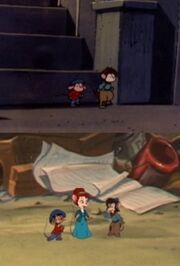
An American Tail: The Mystery of the Night Monster (also known as An American Tail IV: Fievel meets the Night Monster is the second direct-to-video follow-up to An American Tail and the fourth and final film in the An American Tail series, starring Thomas Dekker as the young Fievel Mousekewitz. This film was released in December 9, 1999 in Germany and July 25, 2000 in the USA. Similar to the atrocious second Secret of NIMH movie, the negative reception of the third installment may have caused Universal Studios to cease production on the franchise, but did managed to do the final chapter. Due to concept issues with the previous film, stricter changes were made, like violent sequences are toned down and the characters that debuted in the previous film are replaced with more less-diverse cast. Changes were also made for some of the original characters as well.
Plot
Fievel, his friend, Tony and his sister, Tanya all get jobs at the local newspaper, where the audience is introduced to Nellie, who wants to be an important reporter, but only gets small assignments, as if she were a secretary to Reed, the newspaper's editor. Throughout the film, Tanya tries to win Reed's heart, while Tony tries to get noticed by Reed and promoted to a reporter. Like in the previous movies, where a mouse installation is directly below its human installation counterpart, the newspaper offices the mice work in is directly underneath the newspaper offices the humans work in.
Nellie gets a chance when she is assigned to report mice who disappear overnight into holes that open up on their floor all over New York City. Reed makes up a, as Nellie calls it, "so-called monster" that lives under Manhattan Monster and takes mice away during the night to add more excitement to the otherwise unimportant story, intending to sell more papers. The night monster creates fears among the readers, as could be expected. Fievel begins having nightmares that cause him to lose sleep because of his fear of the monster; the film opens up with Fievel having a dream about being chased by what he thinks the monster looks like. When, through Tanya, he is assigned the job of following Nellie and drawing up interperatations of what the monster looks like based on witness testimony, this makes his insomnia all the worse. A particularly suspicious miniature French poodle named Madame Mousey, who has started living among the mice about this time, appears at every crime scene, claiming to be a fortune teller. The heroes finally decide to investigate her by means of the "dog council" that meets at Central Park. They also search down one of the holes, which leads directly to a group of cats known as the infamous Outlaw Cats hiding in the sewers. Also, all the mice that had disappeared are being held in wood cages there, to be sold off to other cats and eaten.
The night monster itself, a mechanic device with ghastly flashing pictures and a circular saw, is revealed in full when it attacks the mice newspaper office and printing press to prevent them from printing the truth, which they had just discovered. A great chase scene takes place throughout both the mouse and the human newspaper offices. Reed reveals that he was in love with Nellie all along, leaving Tanya intensely disheartned. When all the cats seem to be under control, the "dog council" appears just as they're regaining consciousness and chase them all away, taking Madame Mousey with them. The last scene takes place at the beach, where the audience is told that the "dog council" had chosen for the French poodle (who was the mastermind behind the night monster all along) a punishment worse than prison: returning her to her owner, Mrs. Abernathy. Mama Mousekewitz, Fievel's mother, surmises saying that now that the mystery has been cleared up, Fievel may finally go to sleep, only to turn around and find him already asleep on the beach towel.
Voice Talents
- Thomas Alexander Dekker as Fievel Mousekewitz
- Lacey Chabert as Tanya Mousekewitz
- Nehemiah Persoff as Papa Mousekewitz
- Jane Singer as Mama Mousekewitz
- Dom DeLuise as Tiger
- Pat Musick as Tony Toponi/Mrs. Abernathy
- Susan Boyd as Nellie Brie
- Robert Hays as Reed Daley
- Candi Milo as Madame Mousey
- John Mariano as Twitch
- Jeff Bennett as Slug
- Joe Lala as Bootlick
- Sherman Howard as Haggis
- John Garry as Lone Woof
- Ikue Ohtani as Fievel Mousekewitz
- Hitoshi Takagi as Papa Mousekewitz
- Miyoko Aso as Mama Mousekewitz
Songs
- "Get the Facts"
- "Creature de la Nuit"
- "Who Will"
Animation style

The comparison with the characters shown from the distance between the third and fourth films
In comparison with the two theatrical features in the American Tail series, both direct-to-video releases falter in animation quality, as typical for direct-to-video cartoons. On top of that, Fievel's fur color was desaturated even though the rest of the Mousekewitz family have kept their original fur color. Which direct-to-video film has the better animation seems to be a matter of opinion, but this film did do a better job of the shots where the characters are tiny.
Trivia
- This is the second An American Tail media not to include Erica Yohn as the voice of Mama Mousekewitz. The first was Fievel's American Tails.
- This is the only An American Tail film not to have Tony Toponi romantically involved with anyone else.
- This marks the last role for Nehemiah Persoff for voicing Papa Mousekewitz in a film before retiring from acting to become a full-time painter.
- It is the last role for Dom DeLuise as the voice of Tiger before his death in 2009.
